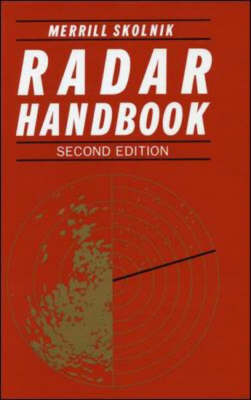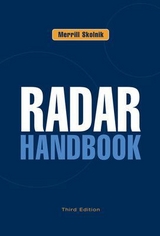
RADAR HANDBOOK
McGraw-Hill Professional (Verlag)
978-0-07-057913-2 (ISBN)
- Titel erscheint in neuer Auflage
- Artikel merken
Thoroughly revised to reflect advances made in radar technology over the past two decades, this second edition of the "Radar Handbook" will be welcomed by radar engineers, designers, and technicians the world over. Growth in radar capability and applications has been-and continues to be -prodigious, and the new material (nearly 75 percent) in this volume reflects that. The handbook covers all the new developments in radar, as well as the fundamentals, making it the standard reference. Each of the 25 chapters is written by an expert or experts in the field; more than half of the authors are new to this edition. A sampling of the many new radar advances includes systems such as: HF over-the-horizon radar for long-range detection; space-based radar for global coverage; doppler weather radar for improved weather forecasting; radar guidance of missiles; and 3D air surveillance radar. It includes technology such as solid-state transmitters, digital signal processing for implementing doppler filters for moving-target indiction, CFAR, and automatic detection and tracking.
The book covers: target and clutter cross-section characteristics, prediction, and measurement; antenna technology ranging from modern reflector antennas to electronically steered phased arrays, low-sidelobe antennas, and adaptive antennas; and, airborne pulse doppler, AMTI, and MTI radar methods for the detection of aircraft in the midst of much larger clutter echoes. With all this and much, much more, including discussions of modern radar transmitters and receivers not available elsewhere, the "Radar Handbook" belongs on the bookshelf of every radar engineer.
About the Editor in Chief Merrill I. Skolnik, known worldwide for his leadership in radar research and development, has been affiliated with the Johns Hopkins Radiation Laboratory, Sylvania, MIT Lincoln Laboratory, the Research Division of Electronic Communications Inc., the Institute for Defense Analyses, and the U.S. Naval Research Laboratory. He received his doctorate in electrical engineering from Johns Hopkins University, where he also earned B.E. and M.S.E. degrees. He is the author of the leading college textbook on radar, Introduction to Radar Systems (McGraw-Hill), now in its second edition, and the editor of Radar Applications. He is a member of the National Academy of Engineering, a Fellow of the IEEE, and has served as editor of the Proceedings of the IEEE.
ContributorsPrefaceChapter 1: An Introduction to Radar (Merrill I. Skolnik)Chapter 2: Prediction of Radar Range (Lamont V. Blake)Chapter 3: Receivers (John W. Taylor, Jr.)Chapter 4: Transmitters (T.A. Weil)Chapter 5: Solid-State Transmitters (Michael T. Borkowski)Chapter 6: Reflector Antennas (Helmut E. Schrank, Gary E. Evans, and Daniel Davis)Chapter 7: Phased Array Radar Antennas (Theodore C. Cheston and Joe Frank)Chapter 8: Automatic Detection, Tracking, and Sensor Integration (G.V. Trunk)Chapter 9: Electronic Counter-Countermeasures (A. Farina)Chapter 10: Pulse Compression Radar (Edward C. Farnett and George H. Stevens)Chapter 11: Radar Cross Section (Eugene F. Knott)Chapter 12: Ground Echo (Richard K. Moore)Chapter 13: Sea Clutter (Lewis B. Wetzel)Chapter 14: CW and FM Radar (William K. Saunders)Chapter 15: MTI Radar (William W. Shrader and V. Gregers-Hansen)Chapter 16: Airborne MTI (Fred M. Staudaher)Chapter 17: Pulse Doppler Radar (William H. Long, David H. Mahoney, and William A. Skillman)Chapter 18: Tracking Radar (Dean D. Howard)Chapter 19: Radar Guidance of Missiles (Alex Ivanov)Chapter 20: Height Finding and 3D Radar (David J. Murrow)Chapter 21: Synthetic Aperture Radar (L.J. Cutrona)Chapter 22: Space-Based Radar Systems and Technology (Leopold J. Cantafio)Chapter 23: Meteorological Radar (Robert J. Serafin)Chapter 24: HF Over-the-Horizon Radar (J.M. Headrick)Chapter 25: Bistatic Radar (Nicholas J. Willis)INDEX
| Erscheint lt. Verlag | 16.12.1989 |
|---|---|
| Zusatzinfo | 700 Illustrations, unspecified |
| Sprache | englisch |
| Maße | 158 x 236 mm |
| Gewicht | 1542 g |
| Themenwelt | Technik ► Elektrotechnik / Energietechnik |
| Technik ► Nachrichtentechnik | |
| ISBN-10 | 0-07-057913-X / 007057913X |
| ISBN-13 | 978-0-07-057913-2 / 9780070579132 |
| Zustand | Neuware |
| Informationen gemäß Produktsicherheitsverordnung (GPSR) | |
| Haben Sie eine Frage zum Produkt? |
aus dem Bereich



